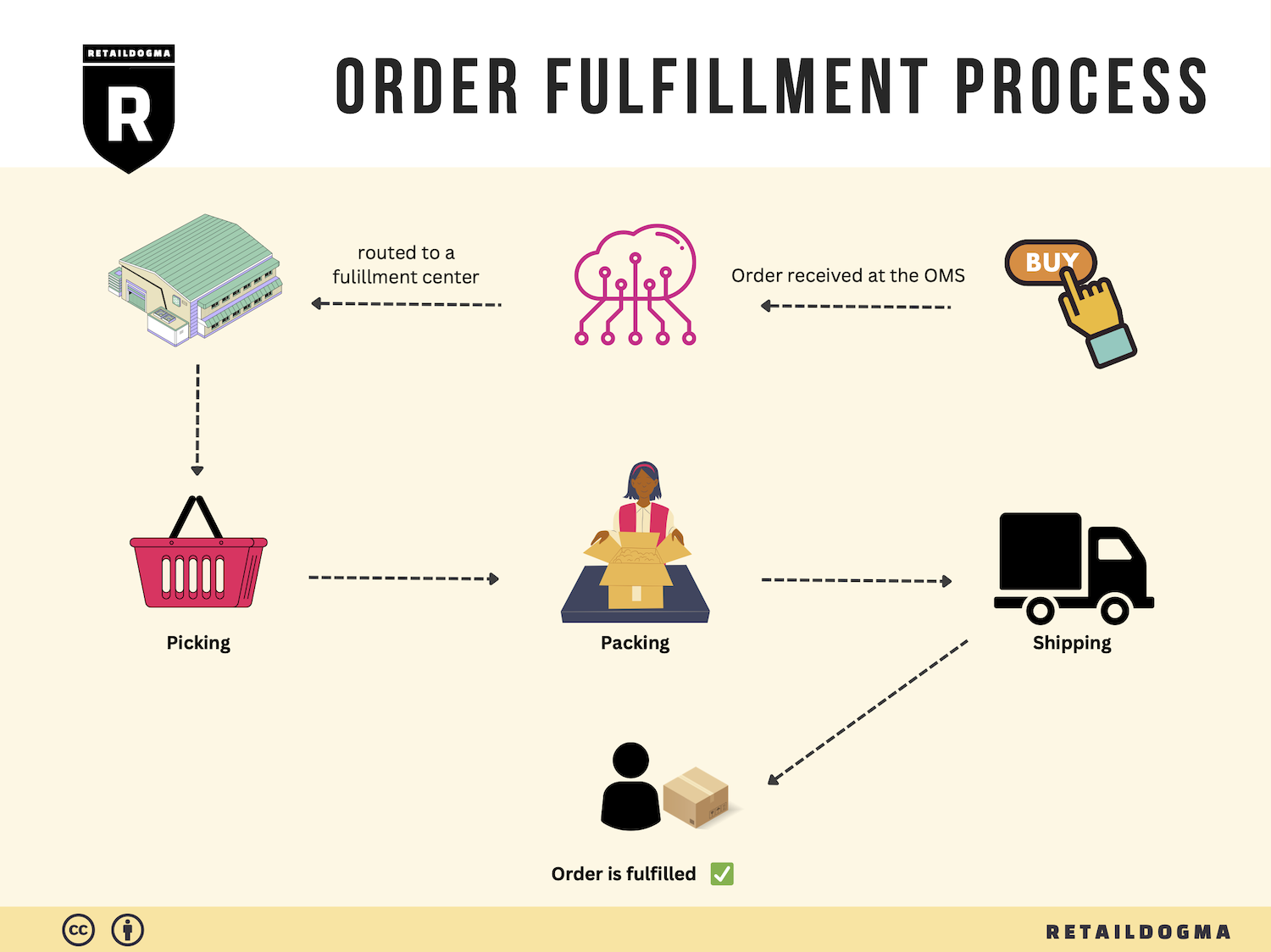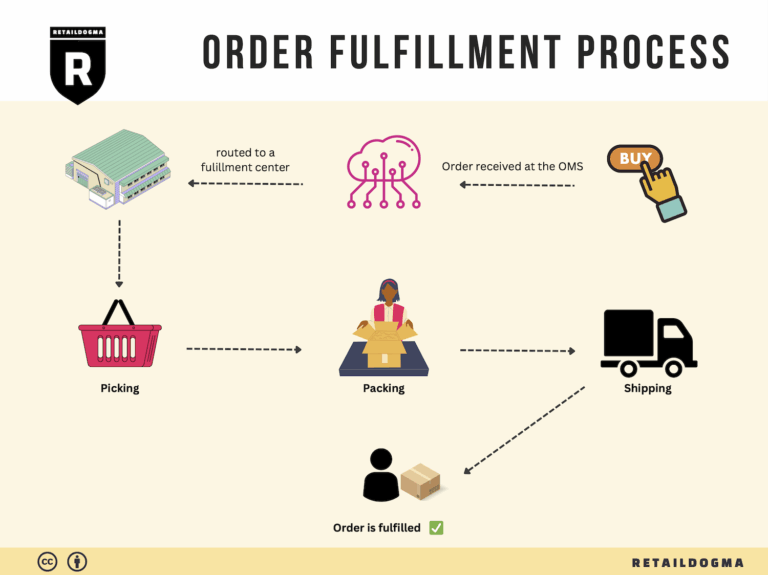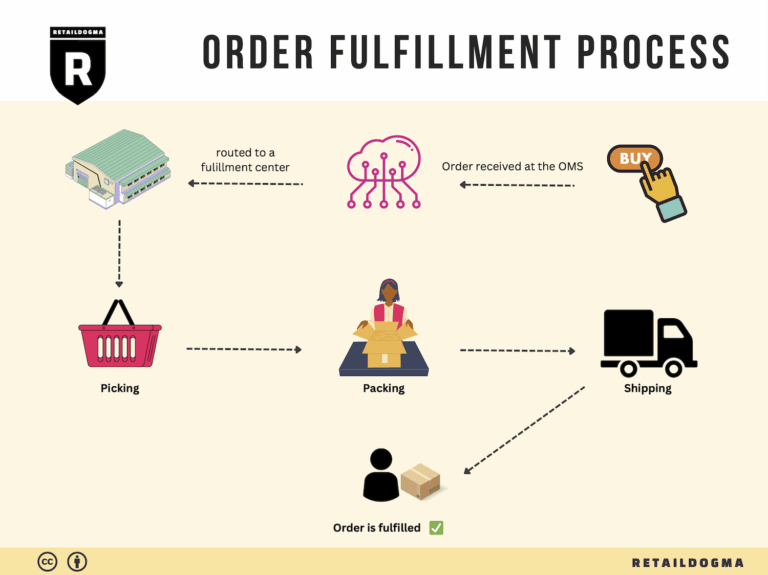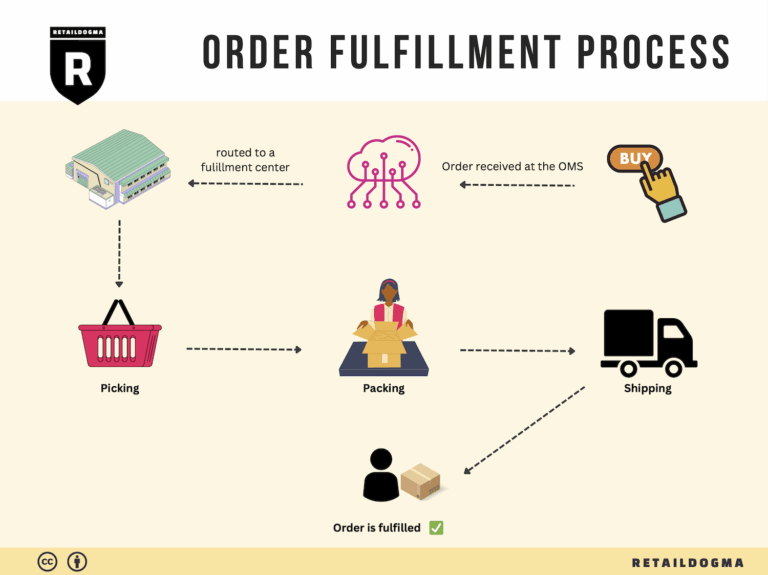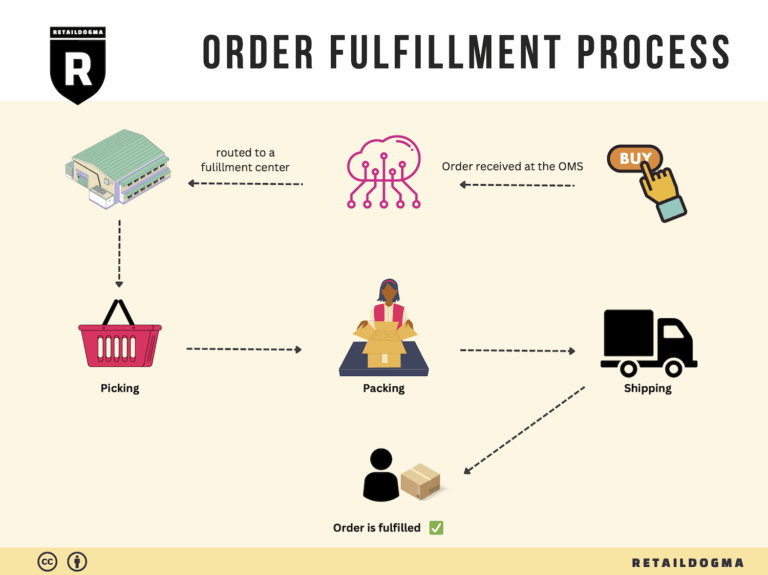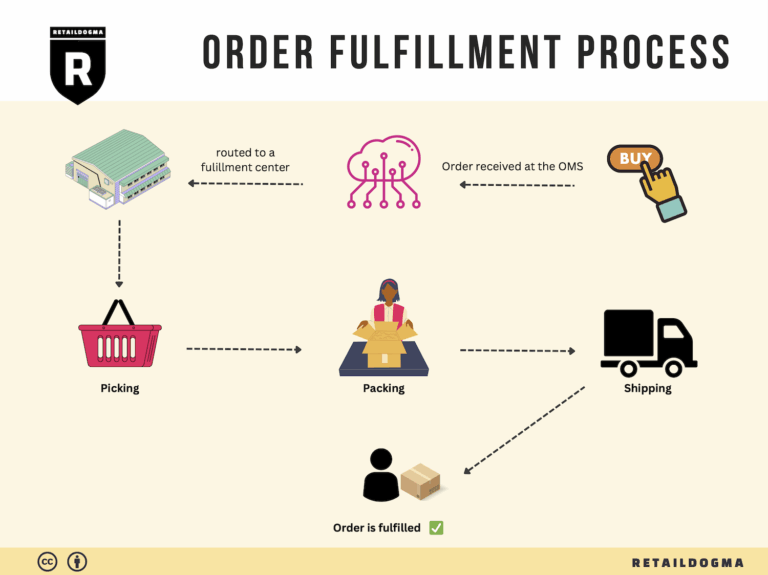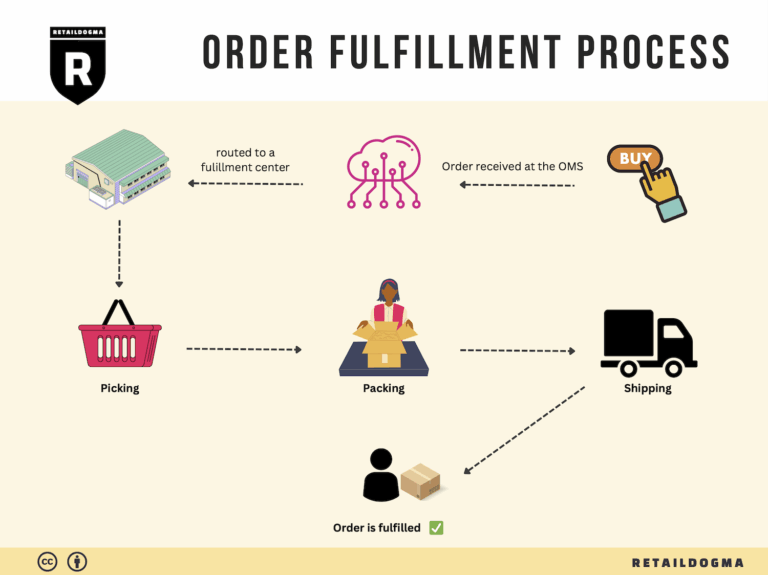Ecommerce Fulfillment Services: The Ultimate Guide (2025)
What is E-commerce Fulfillment? An Introduction for Growing Businesses
Understanding the Fulfillment Process
As an e-commerce business owner, you may find yourself increasingly overwhelmed by the demands of packing and shipping orders. This challenge is common, particularly as your sales begin to scale. Managing inventory, processing orders, and ensuring timely deliveries can quickly become a daunting task. Fortunately, there is a solution: e-commerce fulfillment.
Fulfillment, in simple terms, is the process of getting a product from your warehouse or inventory to the customer’s doorstep. It encompasses everything from receiving inventory and storing products to picking, packing, and shipping orders. As your business grows, understanding and optimizing your fulfillment strategy becomes critical to maintaining customer satisfaction and operational efficiency.
In this guide, we will explore the various fulfillment models available to online retailers, including Fulfillment by Amazon (FBA) and third-party logistics (3PL) providers. Each model has its advantages and considerations, and we will delve into which might be the best fit for your business needs.
Core Services of E-commerce Fulfillment
We will break down the core services involved in the fulfillment process. These include inventory management, order processing, shipping logistics, and customer service. Understanding these components will help you grasp the full scope of fulfillment and how it can impact your business operations.
Choosing the Right Fulfillment Partner
Selecting the right fulfillment partner is a crucial decision for any growing business. We will provide insights into what to look for when evaluating potential partners, including their technology capabilities, service offerings, and reliability. Understanding these factors will empower you to make informed choices that align with your business goals.
Pricing and Cost Considerations
Finally, we will discuss pricing models associated with different fulfillment options. From storage fees to shipping costs, understanding the financial implications of your fulfillment strategy is essential for maintaining profitability as you scale.
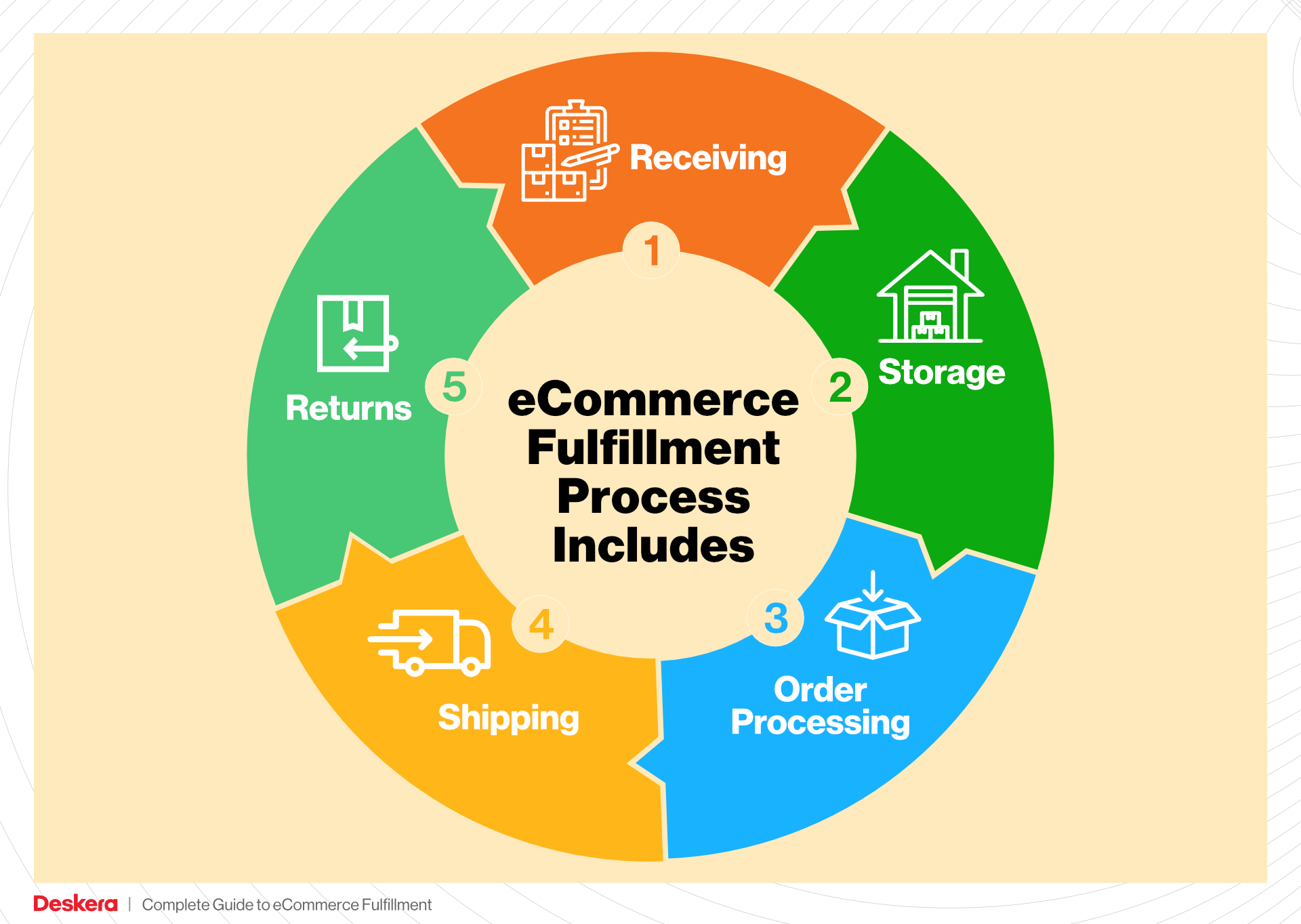
Empowering Your Business Decisions
The ultimate goal of this guide is to empower you with the knowledge and tools necessary to make smart decisions about your logistics. By understanding the e-commerce fulfillment landscape, you can streamline your operations, enhance customer satisfaction, and position your business for sustained growth. Whether you’re just starting or are well on your way to scaling your sales, this guide will be an invaluable resource on your journey.
What You’ll Learn In This Guide
- What is E-commerce Fulfillment? An Introduction for Growing Businesses
- The Order Fulfillment Process: From ‘Buy’ Button to Customer’s Door
- Comparing Fulfillment Models: In-House vs. 3PL vs. Dropshipping
- A Deep Dive into Amazon FBA: Pros, Cons, and Who It’s For
- Core Services Offered by Fulfillment Centers
- How to Choose a Fulfillment Partner: A 6-Point Checklist
- Understanding Fulfillment Pricing: A Breakdown of Common Fees
- Frequently Asked Questions (FAQs) about Fulfillment
- Conclusion: Is Outsourcing Fulfillment the Right Move for Your Business?
- Important Disclaimer
The Order Fulfillment Process: From ‘Buy’ Button to Customer’s Door
1. Receiving Inventory
The order fulfillment process begins with receiving inventory at the fulfillment center. This step is crucial as it sets the foundation for all subsequent operations. When products arrive at the warehouse, they are unloaded from trucks at the inbound dock. This can involve manual labor or the use of forklifts for larger shipments. Each item is carefully checked against a purchase order to ensure accuracy, and any discrepancies are reported immediately.
Key Term: SKU (Stock Keeping Unit)
Each product is assigned a unique SKU, which aids in tracking and managing inventory levels effectively. This identification system is essential for maintaining organization within the warehouse and streamlining the entire fulfillment process. Proper receiving is vital because it directly impacts the efficiency of inventory management and reduces errors during order processing.
2. Warehouse Storage
Once the inventory is received, it is stowed in designated areas within the fulfillment center. The storage process may vary based on the type of items and the fulfillment center’s operational strategy. For instance, Amazon employs sophisticated systems to categorize and store products, often using automated solutions to optimize space and accessibility.
Key Term: Stowing
Stowing refers to the methodical placement of products within the warehouse. It is important because effective stowing practices enhance the retrieval speed of items during order picking. By utilizing technology such as barcode scanning, associates can easily locate products, which minimizes search time and increases overall operational efficiency.
3. Order Picking
The next step in the fulfillment process is order picking, where specific items are retrieved from storage to fulfill customer orders. Once a customer places an order, the fulfillment center generates a picking list—an organized list of items that need to be collected for that order.
Key Term: Pick Lists
A pick list is a critical tool that guides warehouse staff in selecting the right items efficiently. This process can involve manual picking or the use of robots that bring storage pods to the picker, reducing the time spent searching for items. The accuracy of this step is paramount; any mistakes made during picking can lead to incorrect shipments, which can damage customer satisfaction and increase return rates.
4. Order Packing
After items are picked, they move to the packing stage. Here, the focus is on preparing the items for shipment. Associates scan each product to ensure that the correct items are being packed, followed by organizing them according to their destination.
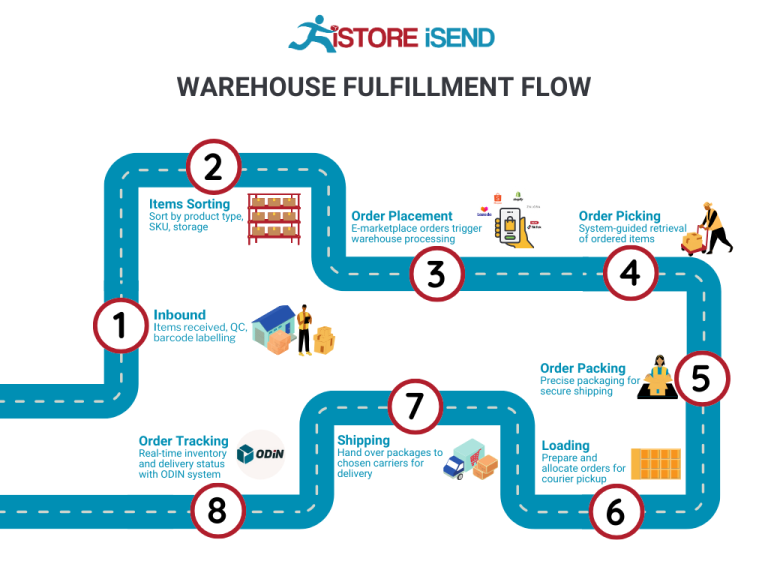
Key Term: Packing Stations
Packing stations are designated areas where orders are assembled and packed for shipping. This step is crucial for ensuring that items are protected during transit. Amazon utilizes a system that recommends the appropriate box size and tape length, minimizing material waste and optimizing packing efficiency. Proper packing is essential not only for protecting products but also for maintaining brand reputation through a professional presentation upon delivery.
5. Shipping & Delivery
The final step in the order fulfillment process is shipping and delivery. Once packed, packages undergo a final quality check, where they are weighed and labeled for shipping. This is where the fulfillment center leverages technology to ensure swift and accurate shipping.
Key Term: SLAM (Scan, Label, Apply, Manifest)
SLAM systems are used to automate the labeling process, significantly increasing efficiency. Once labeled, packages are sorted based on their destination and shipping method, whether they are going out via Amazon’s own delivery network or third-party carriers. This step is critical as it directly impacts delivery speed, particularly for services like Amazon Prime, which promises rapid delivery times to customers. Efficient shipping practices not only enhance customer satisfaction but also contribute to the overall scalability of your e-commerce business.
By understanding and optimizing each step in the order fulfillment process, e-commerce businesses can significantly enhance their operational efficiency, ultimately leading to improved customer satisfaction and business growth.
Comparing Fulfillment Models: In-House vs. 3PL vs. Dropshipping
Fulfillment Models Comparison Table
| Model | Who Handles Inventory | Best For (Business Stage) | Key Advantage | Key Disadvantage |
|---|---|---|---|---|
| In-House Fulfillment | The business itself | Established businesses | Complete control over inventory and fulfillment | High operational costs and resource requirements |
| Third-Party Logistics (3PL) | A third-party logistics provider | Growing businesses | Scalability and reduced overhead costs | Less control over inventory and fulfillment process |
| Dropshipping | Supplier or manufacturer | Startups and small businesses | Low upfront investment and risk | Lower profit margins and reliance on suppliers |
In-House Fulfillment
In-house fulfillment refers to the process where a business manages its own warehousing, inventory management, and order fulfillment. This model is most suitable for established businesses that have the resources to handle logistics internally. The primary advantage of in-house fulfillment is the level of control it provides. Businesses can oversee every aspect of their inventory, from receiving to shipping, ensuring quality and efficiency. Additionally, having direct control allows for customized packaging and branding opportunities that can enhance customer experience.
However, in-house fulfillment comes with significant drawbacks. Operational costs can be high due to the need for warehouse space, staffing, technology, and equipment. This model requires a considerable investment in infrastructure and ongoing operational management, which can strain resources, especially for smaller businesses. As order volumes increase, managing logistics in-house can become increasingly complex and challenging, potentially leading to inefficiencies.
Third-Party Logistics (3PL)
Third-party logistics (3PL) involves outsourcing logistics and fulfillment operations to an external provider. This model is ideal for growing businesses that need to scale quickly without the burden of managing logistics themselves. 3PL providers handle a range of services, including warehousing, inventory management, order processing, and shipping. The key advantage of using a 3PL is scalability; businesses can easily adjust their logistics needs based on fluctuating demand without the need for significant capital investment in infrastructure.
On the downside, using a 3PL means relinquishing some control over inventory and fulfillment processes. Businesses may face challenges in communication and coordination with the 3PL provider, which can lead to inconsistencies in service levels and fulfillment accuracy. Additionally, businesses must carefully select a reliable 3PL partner, as poor service can negatively impact customer satisfaction and brand reputation. It’s essential to establish clear expectations and maintain ongoing communication to ensure a successful partnership.
Dropshipping
Dropshipping is a fulfillment model where a retailer does not keep goods in stock but instead transfers customer orders directly to a supplier or manufacturer, who then ships the products directly to the customer. This model is particularly well-suited for startups and small businesses that want to minimize upfront investment and operational risk. The primary advantage of dropshipping is the low barrier to entry; entrepreneurs can start an e-commerce business with minimal capital since they do not need to invest in inventory upfront.
However, dropshipping also has its challenges. The reliance on suppliers means that businesses have little control over inventory levels, product quality, and shipping times. This can lead to delays and stockouts, which may result in dissatisfied customers. Additionally, profit margins can be lower than with other fulfillment models due to the costs associated with purchasing from suppliers at retail prices. Businesses need to carefully vet suppliers and maintain strong relationships to ensure reliability and quality in their dropshipping operations.
Conclusion
Selecting the right fulfillment model is crucial for e-commerce businesses looking to scale efficiently. In-house fulfillment offers control but comes with high operational costs, while 3PL provides scalability and reduced overhead but requires careful management of external relationships. Dropshipping minimizes investment risk but can lead to challenges in quality control and profitability. Business owners should evaluate their specific needs, budget, and growth plans to determine the most suitable fulfillment strategy for their operations.
A Deep Dive into Amazon FBA: Pros, Cons, and Who It’s For
Understanding Fulfillment by Amazon (FBA)
Fulfillment by Amazon (FBA) is a service provided by Amazon that enables sellers to store their products in Amazon’s fulfillment centers, where Amazon takes care of storage, packaging, shipping, and customer service on behalf of the sellers. This program allows e-commerce businesses to leverage Amazon’s vast logistics network and customer service capabilities, providing an efficient way to manage order fulfillment.
How FBA Works
-
Inventory Shipment: Sellers send their products to Amazon’s fulfillment centers. Upon arrival, Amazon scans the items and adds them to its inventory system.
-
Order Placement: When a customer places an order for a product listed under FBA, Amazon automatically receives the order.
-
Picking and Packing: Amazon’s system selects the appropriate items from its inventory, and fulfillment center staff or robots pick the items. They are then packed using optimized processes to ensure safety and efficiency.
-
Shipping: The packed order is shipped to the customer using Amazon’s logistics network, which may include various shipping methods to ensure timely delivery.
-
Customer Service: Amazon handles all customer service inquiries related to FBA orders, including returns and refunds, which alleviates additional operational burdens for sellers.
Pros of FBA
-
Prime Eligibility: Products fulfilled through FBA are eligible for Amazon Prime, which can significantly increase visibility and sales, as Prime members often prefer items that offer free two-day shipping.
-
Increased Customer Trust: Leveraging Amazon’s trusted brand can enhance credibility. Customers are more likely to purchase from sellers whose products are fulfilled by Amazon due to the perceived reliability of the service.
-
Multi-Channel Fulfillment: FBA isn’t limited to Amazon sales; sellers can use FBA to fulfill orders from their own websites or other platforms, allowing for a streamlined logistics process across multiple sales channels.
-
Scalability: FBA allows businesses to scale their operations without the need to invest heavily in warehousing or logistics. As demand increases, sellers can send more inventory to Amazon without worrying about storage or order processing.
-
Comprehensive Logistics Management: Amazon handles the entire logistics process, from storage to shipping, which frees up time for sellers to focus on other areas of their business, such as product development and marketing.
Cons of FBA
-
High Fees: FBA comes with various fees, including storage fees and fulfillment fees. These costs can add up, especially for sellers with low-margin products or those who have excess inventory that incurs long-term storage fees.
-
Strict Inventory Rules: Amazon has specific policies regarding inventory management, including guidelines on labeling and packaging. Non-compliance can lead to additional charges or even the removal of products from the platform.
-
Commingling Risks: When using FBA, sellers’ products may be stored alongside products from other sellers. This commingling can lead to issues such as receiving damaged or incorrect items, which can negatively affect seller ratings and customer satisfaction.
-
Limited Control Over Fulfillment: Sellers have minimal control over how their products are handled once they are in Amazon’s hands. This lack of control can be concerning, especially for sellers of high-value or delicate items.
-
Complex Returns Management: While Amazon manages returns, the process can be complicated. Sellers may face challenges with return rates that can impact their overall profitability.
Who is FBA Best For?
Fulfillment by Amazon is particularly well-suited for certain types of sellers:
-
Small to Medium-Sized Businesses: Companies that lack the resources to manage logistics efficiently can benefit significantly from FBA, as it allows them to focus on core business functions.
-
Sellers with High Sales Volume: Businesses that anticipate a high sales volume can leverage FBA to ensure fast shipping and customer service without the need for extensive logistics infrastructure.
-
New Sellers: Entrepreneurs just starting out can utilize FBA to gain access to Amazon’s vast customer base and logistics capabilities without needing to build their own fulfillment network.
-
Sellers of Consumer Goods: Brands with products that appeal to Amazon’s customer base, particularly those that are eligible for Prime, are likely to see greater success with FBA.
-
Multi-Channel Sellers: Businesses that sell across different platforms can streamline their fulfillment process using FBA, allowing them to manage orders from various sources more effectively.
In conclusion, Fulfillment by Amazon offers a powerful solution for e-commerce businesses looking to scale their operations. While it provides significant advantages such as Prime eligibility and comprehensive logistics management, it also comes with its own set of challenges, including high fees and strict inventory rules. By weighing these pros and cons, sellers can make informed decisions about whether FBA is the right fit for their business needs.
Core Services Offered by Fulfillment Centers
Inventory Management & Warehousing
Inventory management and warehousing are foundational services provided by fulfillment centers. This process involves the receipt, storage, and tracking of products until they are sold. Fulfillment centers utilize advanced inventory management systems that allow e-commerce businesses to monitor stock levels in real-time, ensuring optimal inventory turnover and reducing the risk of stockouts or overstock situations.
Benefits:
1. Efficiency and Accuracy: Automated systems reduce human error in inventory tracking, leading to more accurate stock levels and fewer discrepancies.
2. Space Optimization: Fulfillment centers are designed to maximize storage efficiency, often utilizing vertical space and sophisticated shelving systems, which can significantly reduce warehousing costs for businesses that would otherwise need to invest in their own storage solutions.
3. Scalability: As e-commerce businesses grow, their inventory needs can fluctuate. Fulfillment centers provide the flexibility to scale storage up or down based on demand without the need for long-term leases or investments in real estate.
Pick and Pack Services
Pick and pack services are critical to the order fulfillment process. This service involves selecting the right products from the warehouse (picking) and packaging them appropriately for shipment (packing). Fulfillment centers employ both human labor and automation to streamline this process, ensuring that orders are fulfilled quickly and accurately.
Benefits:
1. Speed: Fulfillment centers can process orders rapidly due to their optimized picking paths and technology-assisted operations, which is essential for businesses relying on fast delivery times, such as those in the Amazon marketplace.
2. Cost-Effective: By outsourcing pick and pack services, e-commerce businesses can reduce labor costs and focus their resources on other areas, such as marketing and product development.
3. Quality Control: Fulfillment centers often implement quality checks during the picking and packing process, ensuring that the right products are sent to customers, thereby enhancing customer satisfaction and reducing return rates.
Kitting and Assembly
Kitting and assembly involve the grouping of multiple products into a single package or kit. This service is particularly beneficial for businesses that sell products that are often bundled together or require assembly before they can be sold. Fulfillment centers can efficiently create these kits, ensuring that all components are included and properly packaged.
Benefits:
1. Customization: Kitting allows businesses to offer customized products or bundles that can attract customers looking for value. This can increase average order value and improve customer satisfaction.
2. Time Savings: By outsourcing kitting and assembly, businesses can save time and labor costs associated with preparing products for sale, allowing them to focus on core operations and growth strategies.
3. Streamlined Operations: Fulfillment centers are equipped to handle complex kitting requirements, which can streamline the supply chain and reduce the need for businesses to manage multiple suppliers or production processes.
Returns Management (Reverse Logistics)
Returns management, or reverse logistics, is an essential service offered by fulfillment centers, particularly in the e-commerce landscape where return rates can be high. This service encompasses the process of handling returned products, including their inspection, restocking, and disposition.
Benefits:
1. Enhanced Customer Experience: Efficient returns management ensures that customers have a smooth return process, which is crucial for maintaining trust and encouraging repeat purchases. A hassle-free return policy can be a significant competitive advantage.
2. Cost Efficiency: Fulfillment centers can handle returns more efficiently than individual e-commerce businesses, potentially reducing costs associated with processing returns and restocking items.
3. Data Insights: Analyzing return data can provide valuable insights into product quality, customer preferences, and potential improvements in product descriptions or marketing strategies. This can help businesses make informed decisions to reduce return rates in the future.
By leveraging these core services offered by fulfillment centers, e-commerce businesses can significantly enhance their operational efficiency, reduce costs, and improve customer satisfaction. This strategic partnership allows them to focus on growth and scaling their business while leaving the complexities of logistics and fulfillment to the experts.
How to Choose a Fulfillment Partner: A 6-Point Checklist
Location & Warehouse Network
Why It’s Important:
The location of your fulfillment partner’s warehouses can greatly impact shipping costs, delivery times, and overall customer satisfaction. Proximity to your target markets can reduce shipping distances and lead times, which is especially crucial for e-commerce businesses competing on speed.
Questions to Ask:
1. Where are your warehouses located, and how does that align with my customer demographics?
2. Do you have a network of warehouses that can facilitate efficient distribution?
3. How do you handle regional demand fluctuations and seasonal spikes in orders?
Technology & Integrations
Why It’s Important:
In today’s e-commerce landscape, technology plays a critical role in ensuring smooth operations. A fulfillment partner should offer robust technology solutions that integrate seamlessly with your e-commerce platform, inventory management systems, and customer service tools. This can lead to improved accuracy in order processing and better visibility into your inventory levels.
Questions to Ask:
1. What technology do you use for inventory management, order processing, and tracking shipments?
2. Can your systems integrate with my existing e-commerce platform (e.g., Shopify, WooCommerce, Amazon)?
3. Do you provide real-time tracking for both inventory and shipments?
Specializations (e.g., Cold Storage, Oversized Items)
Why It’s Important:
Depending on the nature of your products, you may require a fulfillment partner with specific capabilities. For instance, if you sell perishable goods, you need a partner with cold storage facilities. Similarly, oversized or fragile items require specialized handling and storage solutions.
Questions to Ask:
1. What types of products do you specialize in, and do you have the necessary facilities (e.g., climate control, custom packaging) for my items?
2. How do you handle inventory that requires special conditions?
3. Can you accommodate unique packaging or labeling requirements for my products?
Scalability & Capacity
Why It’s Important:
As your business grows, your fulfillment needs will evolve. A good fulfillment partner should have the capacity to scale operations in line with your growth—whether that means increasing warehouse space, workforce, or technology capabilities. This ensures that you can meet customer demand without disruptions.
Questions to Ask:
1. How do you handle fluctuations in order volume, especially during peak seasons?
2. What are your warehouse capacity limits, and how quickly can you scale up if needed?
3. Can you provide examples of how you’ve supported other clients in scaling their operations?
Pricing and Contracts
Why It’s Important:
Understanding the pricing structure and contract terms is vital for budgeting and ensuring that your fulfillment costs align with your business model. Hidden fees can quickly erode your margins, so clarity in pricing is essential.
Questions to Ask:
1. What is your pricing model (e.g., per order, per item, storage fees), and what additional fees should I be aware of?
2. Are there minimum order requirements or long-term contracts that I should consider?
3. How do you handle pricing adjustments as my business grows or changes?
Customer Support & Reviews
Why It’s Important:
Effective customer support can make or break your experience with a fulfillment partner. You need a partner that is responsive and proactive in addressing any issues that arise. Additionally, reviews from other businesses can provide insight into the partner’s reliability and service quality.
Questions to Ask:
1. What customer support options do you provide (e.g., phone, email, chat), and what are your response times?
2. Can you share testimonials or case studies from other clients in my industry?
3. How do you handle disputes or issues that may arise during the fulfillment process?
Conclusion
Choosing the right fulfillment partner is a critical decision that can significantly impact your e-commerce operations. By considering these six essential points—Location & Warehouse Network, Technology & Integrations, Specializations, Scalability & Capacity, Pricing and Contracts, and Customer Support & Reviews—you can make a more informed choice that aligns with your business goals and enhances your customer experience. Take the time to thoroughly vet potential partners, ask the right questions, and ensure they meet the specific needs of your business as you scale.
Understanding Fulfillment Pricing: A Breakdown of Common Fees
Initial Setup Fees
When partnering with an Amazon Fulfillment Center like RIC2, new sellers often encounter initial setup fees. These fees are typically charged to establish your seller account and integrate your inventory into the Fulfillment by Amazon (FBA) system. The setup may include account verification, software configuration, and training on the platform.
These fees can vary based on the complexity of your business needs and the specific services you require. Some sellers may find that there are no upfront costs if they are using basic FBA services, while others with more extensive requirements may incur charges ranging from a few hundred to several thousand dollars. It’s essential to carefully review any contracts and understand what is included in the initial setup to avoid unexpected costs.
Receiving Fees
Once your inventory is sent to the fulfillment center, receiving fees come into play. These fees are charged for the labor and resources involved in unloading, inspecting, and storing your products. Receiving fees are typically calculated based on the volume or weight of the shipment.
For example, Amazon may charge a fixed rate per pallet received or a per-unit fee for smaller items. Understanding the structure of these fees is crucial, as they can significantly impact your overall fulfillment costs, especially if you frequently send large shipments or have a diverse product range. Sellers should also keep in mind that any discrepancies in shipment quantities may lead to additional fees for reprocessing or adjustments.
Storage Fees (per pallet/bin)
Storage fees are charged for keeping your inventory in the fulfillment center. Amazon typically assesses these fees on a monthly basis and can be calculated per pallet or per cubic foot, depending on your inventory’s configuration.
For example, during peak seasons like the holidays, storage fees may increase to encourage sellers to manage their inventory levels effectively. Regular storage fees apply year-round, while additional long-term storage fees may apply to items stored for over six months. To minimize these costs, sellers should monitor their inventory turnover rates and consider seasonal demand fluctuations when planning their stock levels.
Pick & Pack Fees (per item/order)
Pick and pack fees are incurred each time an order is fulfilled. These fees cover the labor and materials needed to pick the items from storage, pack them securely, and prepare them for shipment. Amazon typically calculates these fees based on the number of items in an order, with charges for each item picked and packed.
For instance, if a customer orders three different items from your store, you will be charged a pick and pack fee for each item, which can add up quickly. Sellers should be mindful of this when designing product bundles or multi-item orders. Offering fewer variations or optimizing inventory to reduce the number of picks may help in reducing overall fulfillment costs.
Shipping Fees
Shipping fees are one of the most significant costs associated with fulfillment. These fees depend on various factors, including the shipping method, package weight, dimensions, and destination. Amazon has established partnerships with various carriers, which can influence shipping rates and delivery speeds.
For instance, Prime members receive expedited shipping at no additional cost, which can affect your shipping fees if you are fulfilling orders for Prime customers. Sellers should consider the implications of shipping fees on their pricing strategy and overall profitability. Additionally, utilizing Amazon’s multi-channel fulfillment options can help streamline shipping processes and potentially reduce costs.
Tips for Getting an Accurate Quote
To obtain an accurate quote for fulfillment services, sellers should take the following steps:
-
Provide Detailed Inventory Information: Be clear about the types of products you plan to send, including dimensions, weight, and packaging requirements. This information is vital for calculating receiving, storage, and shipping fees.
-
Understand Your Volume: Estimate your monthly order volume to help the fulfillment center provide a more accurate quote, especially for storage and pick & pack fees.
-
Ask About Discounts: Inquire about volume discounts or special rates for long-term partnerships. Some fulfillment centers may offer better pricing as your order volume increases.
-
Clarify Additional Fees: Ensure you understand all potential additional fees, including those for returns, long-term storage, or inventory discrepancies, to avoid surprises.
-
Request a Detailed Breakdown: Ask for a comprehensive breakdown of all fees associated with your fulfillment services. This transparency will help you budget effectively and make informed decisions.
By following these guidelines, e-commerce business owners can effectively navigate the complexities of fulfillment pricing and ensure that their operations are both efficient and cost-effective.
Frequently Asked Questions (FAQs) about Fulfillment
1. What is the Amazon Fulfillment Center RIC2?
The Amazon Fulfillment Center RIC2, located in Chester, Virginia, is a facility dedicated to processing and fulfilling orders for Amazon and its sellers using the Fulfillment by Amazon (FBA) program. It covers approximately 1 million square feet and is equipped to handle a vast volume of inventory and orders efficiently.
2. How does the Fulfillment by Amazon (FBA) program work?
FBA allows sellers to store their products in Amazon’s fulfillment centers. When a customer orders a product, Amazon takes care of the picking, packing, shipping, and customer service. This program enables sellers to leverage Amazon’s logistics network, ensuring quick delivery and access to Prime customers.
3. What are the key activities performed at the RIC2 fulfillment center?
At RIC2, several key activities are performed, including:
– Inventory Receiving: Products are received and sorted.
– Inventory Storage: Items are stored in an organized manner using barcode scanning.
– Order Processing: Orders are received and processed automatically.
– Order Picking: Items are picked based on customer orders, often utilizing robotic assistance.
– Order Packing: Items are packed efficiently to minimize waste.
– Order Shipping: Packages are labeled and shipped using various transportation methods.
4. What is the difference between a warehouse and a fulfillment center?
A warehouse primarily focuses on storing products, while a fulfillment center specializes in the entire order fulfillment process, including receiving, storing, picking, packing, and shipping orders. Fulfillment centers are designed for speed and efficiency to meet customer demand.
5. How much do fulfillment services cost?
Fulfillment service costs can vary widely depending on several factors, including the volume of orders, storage space used, and specific services required (e.g., packaging, shipping speed). On average, sellers can expect to pay fees for storage and fulfillment, which may range from a few dollars per order to more significant monthly storage fees based on the amount of inventory stored.
6. What is a 3PL, and how does it relate to fulfillment?
A 3PL, or third-party logistics provider, is a company that offers outsourced logistics services, including warehousing, fulfillment, and transportation. While Amazon’s fulfillment centers (like RIC2) serve as in-house logistics solutions for sellers using FBA, 3PL providers can offer similar services outside of the Amazon ecosystem, catering to businesses that sell on multiple platforms.
7. How does sales tax work for inventory stored at RIC2?
As per a ruling from Virginia’s Tax Commissioner, simply storing inventory at the RIC2 fulfillment center does not create a sales tax nexus in Virginia. Sellers need to consider other business activities in the state to determine their sales tax obligations.
8. Can I track my inventory stored at the RIC2 fulfillment center?
Yes, Amazon provides sellers with comprehensive tools to track their inventory levels, order status, and fulfillment metrics through their Seller Central platform. This transparency allows sellers to manage their inventory effectively and plan for restocking.
9. What are the benefits of using the RIC2 fulfillment center for my e-commerce business?
Utilizing RIC2 offers several benefits, including:
– Fast Shipping: Access to Amazon’s logistics network ensures quick delivery.
– Scalability: Easily scale your operations as your business grows without the need for additional infrastructure.
– Customer Trust: Products fulfilled by Amazon often enjoy increased visibility and trust from customers, especially Prime members.
– Reduced Operational Burden: Outsourcing fulfillment allows you to focus on other aspects of your business, such as marketing and product development.
10. How do I get started with Fulfillment by Amazon at RIC2?
To get started with FBA, you need to create an Amazon seller account and enroll in the FBA program. Once enrolled, you can prepare your products, ship them to the RIC2 fulfillment center, and Amazon will handle the rest, including order fulfillment and customer service.
Conclusion: Is Outsourcing Fulfillment the Right Move for Your Business?
Evaluating the Benefits of Outsourcing Fulfillment
Outsourcing fulfillment can be a game-changer for e-commerce businesses looking to scale effectively. One of the primary advantages is the significant time savings it offers. By entrusting your fulfillment processes to experts, you can redirect your focus toward core business activities such as marketing, product development, and customer engagement. This transition allows you to optimize your operations without being bogged down by the intricacies of warehousing and logistics.
Scalability is another critical benefit. As your sales volume increases, managing inventory, order processing, and shipping can become increasingly complex. A reliable fulfillment partner can seamlessly handle fluctuations in demand, ensuring that you can meet customer expectations without compromising service quality. This flexibility is essential in today’s fast-paced market, where customer satisfaction is paramount.
Moreover, leveraging the expertise of a fulfillment service can significantly enhance operational efficiency. These providers utilize advanced technology and streamlined processes that reduce errors and improve delivery times. For instance, Amazon’s fulfillment centers employ sophisticated inventory management systems that optimize picking, packing, and shipping, ensuring a smooth flow of operations.
However, selecting the right fulfillment partner is crucial for long-term growth. Consider factors such as location, technology, service offerings, and customer support. A partner that aligns with your business goals can not only facilitate growth but also enhance your brand’s reputation.
Next Steps: Audit Your Current Shipping Process
To determine if outsourcing fulfillment is the right move for your business, conduct a thorough audit of your current shipping and fulfillment processes. Identify bottlenecks, inefficiencies, and areas where you are investing excessive time or resources. This analysis will provide clarity on whether a fulfillment partner could add value to your operations and help you scale effectively. Taking this proactive step can set the foundation for informed decision-making and sustainable growth.
Important Disclaimer
⚠️ Important Disclaimer
The information in this guide is for educational purposes. Fulfillment services, pricing, and platform features change frequently. Always conduct your own due diligence and consult with providers directly before making business decisions.
